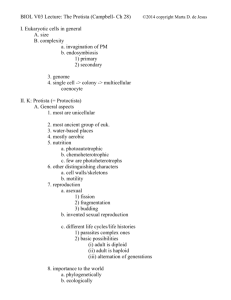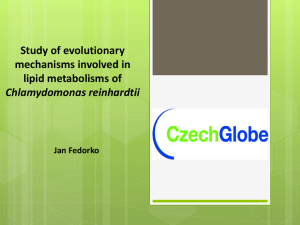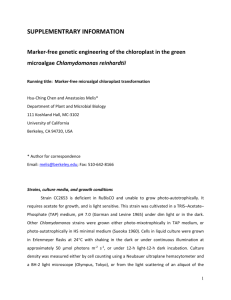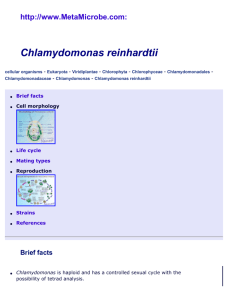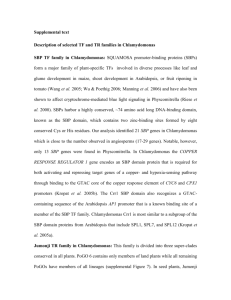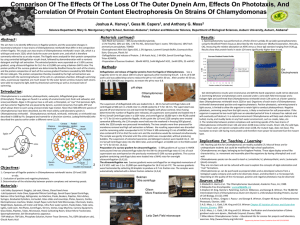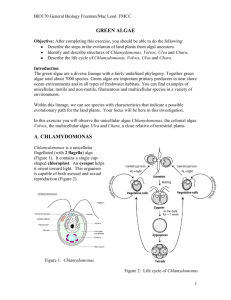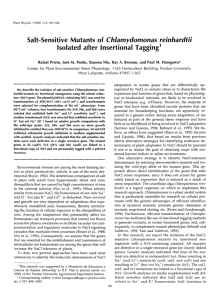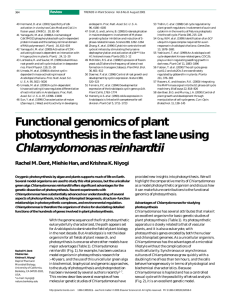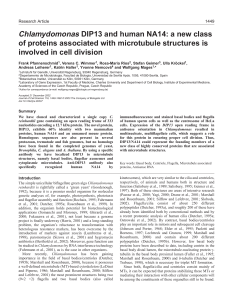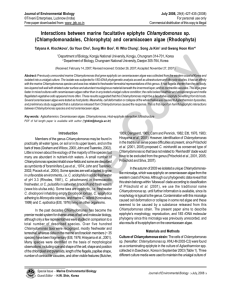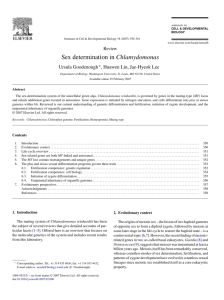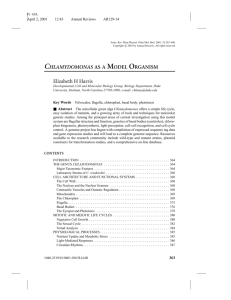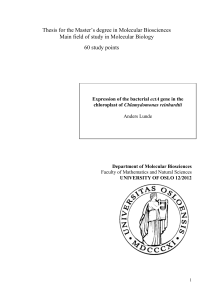Algae under stress - Harper Adams University
advertisement
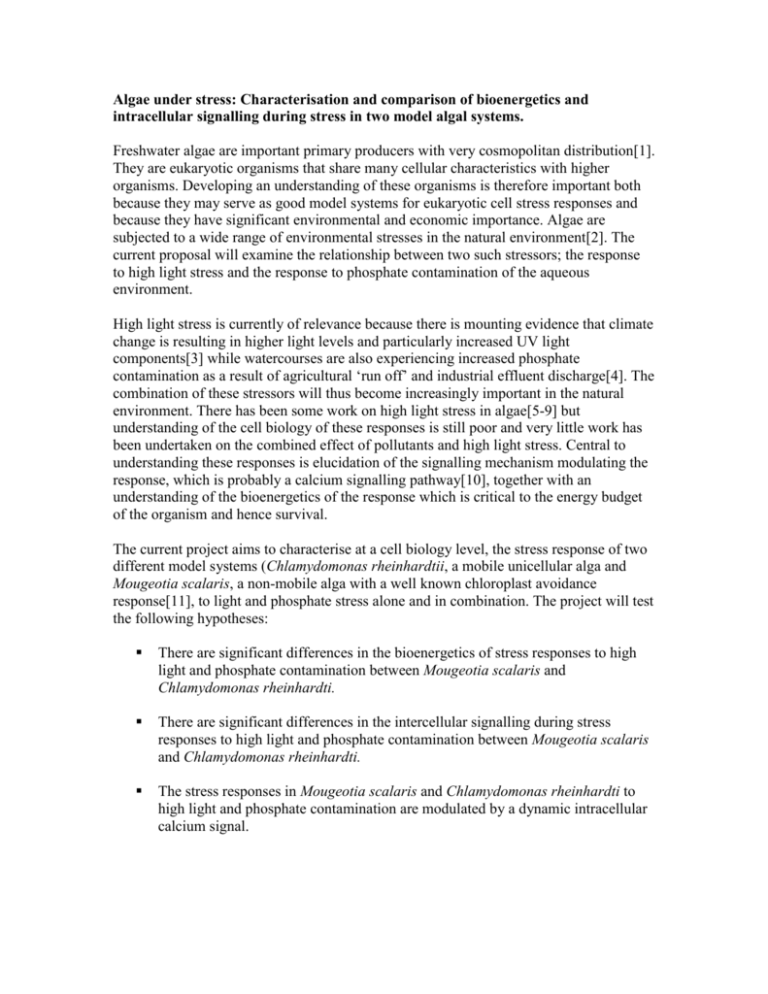
Algae under stress: Characterisation and comparison of bioenergetics and intracellular signalling during stress in two model algal systems. Freshwater algae are important primary producers with very cosmopolitan distribution[1]. They are eukaryotic organisms that share many cellular characteristics with higher organisms. Developing an understanding of these organisms is therefore important both because they may serve as good model systems for eukaryotic cell stress responses and because they have significant environmental and economic importance. Algae are subjected to a wide range of environmental stresses in the natural environment[2]. The current proposal will examine the relationship between two such stressors; the response to high light stress and the response to phosphate contamination of the aqueous environment. High light stress is currently of relevance because there is mounting evidence that climate change is resulting in higher light levels and particularly increased UV light components[3] while watercourses are also experiencing increased phosphate contamination as a result of agricultural ‘run off’ and industrial effluent discharge[4]. The combination of these stressors will thus become increasingly important in the natural environment. There has been some work on high light stress in algae[5-9] but understanding of the cell biology of these responses is still poor and very little work has been undertaken on the combined effect of pollutants and high light stress. Central to understanding these responses is elucidation of the signalling mechanism modulating the response, which is probably a calcium signalling pathway[10], together with an understanding of the bioenergetics of the response which is critical to the energy budget of the organism and hence survival. The current project aims to characterise at a cell biology level, the stress response of two different model systems (Chlamydomonas rheinhardtii, a mobile unicellular alga and Mougeotia scalaris, a non-mobile alga with a well known chloroplast avoidance response[11], to light and phosphate stress alone and in combination. The project will test the following hypotheses: There are significant differences in the bioenergetics of stress responses to high light and phosphate contamination between Mougeotia scalaris and Chlamydomonas rheinhardti. There are significant differences in the intercellular signalling during stress responses to high light and phosphate contamination between Mougeotia scalaris and Chlamydomonas rheinhardti. The stress responses in Mougeotia scalaris and Chlamydomonas rheinhardti to high light and phosphate contamination are modulated by a dynamic intracellular calcium signal. The stress response in Mougeotia scalaris and Chlamydomonas rheinhardti to high light and phosphate contamination stress in combination, differs to the stress response to either stressor alone. The project will be based on pure cultures of each organism kept under controlled conditions of nutrition and light. Light stress will be delivered using a custom built apparatus able to deliver controlled levels of high light illumination over a variable stress period while phosphate stress will be delivered by means of addition of this contaminant to culture media. The stress responses will be characterised by means of a combination of Clark oxygen electrode analysis of the photosynthetic response of the organisms, by HPLC determination of pigment changes, especially of the carotenoids together with vital and fixed cell microscopy as outlined below. The stress responses at an intracellular level will be assessed in terms of changes in bioenergetics of the cells and in terms of the presence and pattern of dynamic calcium signals using vital cell microscopy[12]. An outline of the parameters to be measured for each of these is shown in Table 1. Cellular bioenergetics during and following the stress response Distribution and movement of mitotracker orange labelled mitochondria Changes in the mitochondrial potential assessed using TRME, JC-1and rhodamine -123 Changes in superoxide and peroxide production within the mitochondria Calcium signalling Degree and propagation of cytoplasmic calcium signals during the stress response and recovery period assessed using FURA ratiometric calcium signals Degree of modulation of calcium signal by mitochondrial calcium uptake / release assessed using RHOD-AM mitochondrial targeted calcium sensitive dye Pattern of movement and potential changes within calcium containing vesicles assessed using lysosensor blue / yellow Changes in ATP production and usage during the response measured using a combination of ATPase blockers and uv uncaging of caged ATP to deliver a known ATP dose to specific areas within the cell Table 1: Key live cell imaging techniques proposed. The live cell imaging will be based on an optical fluorescence microscope which has optical sectioning capabilities based on controlled z movements and then optical deconvolution[13] (Olympus BX61 with Hyugens and Image Pro plus software). Data collected will be analysed by use of SPSS and Prism to characterise the stress responses of the model organisms and to compare them to each other. Logistic regression will be used to explore the interaction of the stressors with each other in each model system. It is expected that the PhD will be completed in a 5 year 3 day per week time frame. The initial 6 months will be spent optimising culture conditions, organising the equipment needs and developing the initial imaging set up (for example environmental chamber optimisation and light levels etc). The next 12 months will be spent characterising the baseline responses of the model organisms (for example the non stressed light curves in the oxygen electrode), optimising the loading conditions for dye loading and developing the deconvolution parameters for deconvolution of the live cell data. The 24 months following this will be utilised collecting the experimental data on each model system under the range of single and combined stressors using the techniques outlined above. The final 18 months will be spent revising such experimental data as required and completing the thesis write up. The literature review and write up will be concentrated at the beginning and end of the project but will also be undertaken throughout the project. References 1. Lee, R.E., Phycology. 3 ed. 1999, Cambridge: cambridge university Press. 2. Mendez-Alvarez, S., U. Leisinger, and R.I. Eggen, Adaptive responses in Chlamydomonas reinhardtii. Int Microbiol, 1999. 2(1): p. 15-22. 3. Hader, D.P., Effects of solar UV-B radiation on aquatic ecosystems. Adv Space Res, 2000. 26(12): p. 2029-40. 4. Reynolds, C.S. and P.S. Davies, Sources and bioavailability of phosphorus fractions in freshwaters: a British perspective. Biol Rev Camb Philos Soc, 2001. 76(1): p. 27-64. 5. Grossman, A.R., M. Lohr, and C.S. Im, Chlamydomonas reinhardtii in the landscape of pigments. Annu Rev Genet, 2004. 38: p. 119-73. 6. Baroli, I., et al., Photo-oxidative stress in a xanthophyll-deficient mutant of Chlamydomonas. J Biol Chem, 2004. 279(8): p. 6337-44. 7. Im, C.S. and A.R. Grossman, Identification and regulation of high light-induced genes in Chlamydomonas reinhardtii. Plant J, 2002. 30(3): p. 301-13. 8. Forster, B., C.B. Osmond, and B.J. Pogson, Improved survival of very high light and oxidative stress is conferred by spontaneous gain-of-function mutations in Chlamydomonas. Biochim Biophys Acta, 2005. 1709(1): p. 45-57. 9. Teramoto, H., T. Itoh, and T.A. Ono, High-intensity-light-dependent and transient expression of new genes encoding distant relatives of light-harvesting chlorophyll-a/b proteins in Chlamydomonas reinhardtii. Plant Cell Physiol, 2004. 45(9): p. 1221-32. 10. Hetherington, A. and C. Brownlee, The generation of Ca2+ signals in plants. Annual Review Plant Biology, 2004. 55: p. 401-27. 11. Haupt, W. and J. Fetzer, Energetics Of The Chloroplast Movement In Mougeotia. Nature, 1964. 201: p. 1048-9. 12. Stephens, D.J. and V.J. Allan, Light Microscopy Techniques for Live Cell Imaging. Science, 2003. 300: p. 82-86. 13. Swedlow, J.R. and M. Platani, Live cell imaging using wide field microscopy and deconvolution. Cell structure and function, 2002. 27: p. 335-341.
